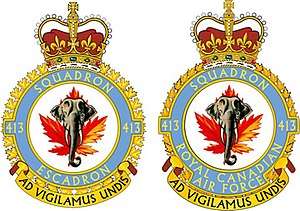413 Transport and Rescue Squadron
| 413 Transport and Rescue Squadron | |
|---|---|
 Squadron badge | |
| Active |
1941–1945 1947–1950 1951–1961 1968–present |
| Country |
|
| Branch |
|
| Role | Transport and rescue |
| Part of | 14 Wing Greenwood |
| Home station | CFB Greenwood |
| Nickname(s) | Tusker |
| Motto(s) |
Ad vigilamus undis ("We watch the waves") |
| Battle honours |
|
| Insignia | |
| Squadron Badge | Elephant head over a maple leaf |
| Aircraft flown | |
| Fighter | F-86 Sabre, Avro CF-100 |
| Patrol | PBY Catalina |
| Transport |
C-130 Hercules CH-149 Cormorant |
413 Transport and Rescue Squadron is an air force squadron of the Canadian Armed Forces. It was originally a flying boat squadron of the Royal Canadian Air Force during the Second World War. It currently operates the C-130 Hercules and the CH-149 Cormorant in transport plus search and rescue roles at CFB Greenwood.
History
413 Squadron was created as the third RCAF squadron attached to the RAF Coastal Command and equipped with PBY Catalina flying boats. The squadron gained fame for the actions of Squadron Leader Leonard Birchall, who detected a large Japanese task force approaching Ceylon. This allowed time for the defenders to prepare, and foiled what could have been a major blow to the Royal Navy in the Indian Ocean. The squadron was disbanded in February 1945.
Reformed at RCAF Rockcliffe on April 1, 1947, it took over the duties of No. 13 (Photographic) Squadron. It operated in this role until November 1, 1950.
The squadron reformed again on August 1, 1951, as a fighter squadron at CFB Bagotville. Equipped with the F-86 Sabre they deployed to Zweibrücken, Germany. The squadron stood down on April 7, 1957, and was then reformed on May 1 operating the Avro CF-100 Canuck at Bagotville. The squadron again disbanded on December 30, 1961.
The squadron was reactivated at CFB Summerside on July 8, 1968, in its current role of a Transportation and Rescue Squadron. With the closure of Summerside, the squadron relocated to CFB Greenwood on June 10, 1991.
On July 13, 2006, 413 Squadron suffered the first fatal crash of a Cormorant in Canadian service when a CH-149 (Aircraft 149914) based at CFB Greenwood crashed while conducting a night training exercise near Canso, Nova Scotia. Killed in the incident were Sgt. Duane Brazil, 39; Master Cpl. Kirk Noel, 33; and Cpl. Trevor McDavid, 31, four other crew members were injured.
On Aug 21st, 2015, LCol Scott Murphy handed over command of 413 Sqn to LCol James Marshall.
References
- Notes
- Bibliography
- Baker, D.J. A History of 413 Squadron. Renfrew, Ontario: General Store Publishing House, 1997. ISBN 1-896182-77-1.
- Halley, James J. The Squadrons of the Royal Air Force & Commonwealth, 1981-1988. Tonbridge, Kent, UK: Air Britain (Historians) Ltd., 1988. ISBN 0-85130-164-9.
- Rawlings, John D.R. Coastal, Support and Special Squadrons of the RAF and their Aircraft. London: Jane's Publishing Company Ltd., 1982. ISBN 0-7106-0187-5. pp. 238–239.
- "No. 413 Squadron". canadianwings.com. 2013. Retrieved 10 September 2013.
- "413 Transport and Rescue Squadron". Royal Canadian Air Force. 2013. Retrieved 10 September 2013.
- McNeill, Ross (August 1999). "No.413 (Tusker) Squadron RCAF". rafcommands.com. Retrieved 10 September 2013.
External links
- Flying Officer H. A. Halliday (September 1963). "The Tuskers' Tale: Squadron No. 413" (PDF). The Roundel. Vol. 15 no. 7. Royal Canadian Air Force. Archived from the original (PDF) on 8 August 2014.
| Wikinews has News related to this article: | |